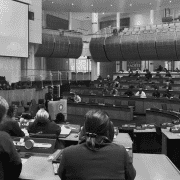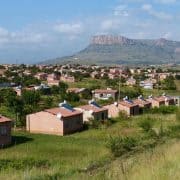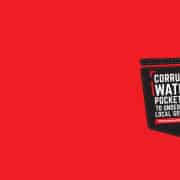|
Getting your Trinity Audio player ready...
|
Last year’s local government elections, held on 3 November 2021, yielded results that were disappointing to some, pleasing to others, and unexpected by very few.
For the first time in its history of governing the country, the ANC’s voter support dropped below 50%. Overall, the party took 45.6% of the vote, down from 53.9% in 2016. Meanwhile, smaller parties and new or resurgent parties won a substantial proportion of votes from the bigger or established parties, despite the lowest voter turnout in the history of democratic elections in South Africa (just 45.9%).
Just before voting day Good Governance Africa, which since 2016 has tracked the performance of the country’s municipalities via its Governance Performance Index (GPI), released the third version of the index. The GPI, says the organisation, measures how well, or poorly, individual municipalities have been performing, based on data gathered and assessed in terms of 20 indicators under three primary governance categories: Administration, Service Delivery, and Planning and Monitoring. The eight metro municipalities have an extra indicator, Development, because of their bigger budget capacity.
Service delivery is key
But no matter the size of the municipality, GGA places service delivery as the most important category. Factors such as access to piped water, flush toilet connected to sewerage, access to electricity, and weekly refuse removal influence municipalities’ ranking.
The GPI results highlight the deep need for a shakeup in the governance structures of a large number of South Africa’s municipalities. Less than three months into the new dispensation, it is too early to tell if anything is improving, but the GPI assists with singling out the municipalities that need to be monitored.
The index provides more than just a comparison. Its prime purpose, according to GGA, is to “reflect the importance of good governance at the local municipal level and … a tool to influence national-level policy that can improve local governance”.
GGA also describes it as “a tool that aids investment decision-making, as it provides a snapshot of the attractiveness of each local municipality – where local infrastructure is well maintained and key services are delivered efficiently and responsibly, businesses can flourish”.
And flourishing businesses create jobs – a desperate need given the country’s all-time high unemployment rate of 34.9%, recorded in the third quarter of 2021.
Additionally, says GGA, the GPI serves as a performance improvement incentive and benchmark against which local municipalities can track their performance. In this way municipalities can be more accountable to their citizens for better performance (by aiming to achieve a better score in the next round and moving up the rank).
The good and the bad
Municipalities are scored between 1 and 8, with 1 being the best. Thirteen of the top 20 municipalities are in the Western Cape and two are in Gauteng. KwaZulu-Natal, Limpopo, Eastern Cape, Northern Cape, and Mpumalanga have one each. One top 20 Western Cape municipality, Kannaland, has been under provincial administration since December 2016. In total, municipalities under administration amount to 12.2% of the total number. In the North West province the situation is particularly dire, with 10 out of 18 local municipalities currently under administration.
The Cape Agulhas Local Municipality (score: 1) came out tops, followed by Bergrivier Local Municipality (1.02) and Saldanha Bay Local Municipality (1.03) – all are in the Western Cape.
In the bottom 20, five municipalities are located in Limpopo and KwaZulu-Natal apiece, and four from the Eastern Cape, two each from the Western Cape and Northern Cape provinces, and one each from Mpumalanga and the Free State. None of these are under administration.
The worst-performing municipality is Msinga Local Municipality (3.78) in KwaZulu-Natal, preceded by the Eastern Cape’s Ingquza Hill Local Municipality (3.69) and third from the bottom, Tokologo Local Municipality (3.64) in the Free State. The voter turnout in both Msinga and Tokologo was over 56%, though Inqguza Hill managed around 45%, so it remains to be seen whether the votes cast will have a positive effect on the running of these municipalities.
In terms of the eight metros, City of Cape Town made the best showing, followed by City of Tshwane, City of Johannesburg, and Nelson Mandela Bay, while City of eThekwini filled the last position on the list. The bottom four – Mangaung, Buffalo City, Ekurhuleni, and eThekwini – were significantly poorer in administration than the other four, which dragged their scores down.
“In the case of eThekwini and Ekurhuleni, this was due to them running substantial budget deficits in the 2018/19 and 2019/20 fiscal years, while Buffalo City and Mangaung were adversely scored due to their lack of an unqualified audit in each of the fiscal years of 2017/18, 2018/19 and 2019/20,” GGA notes.
The overall scores did not differ widely despite this. The metros are scored from 1 to 5, with 1 being the best and 5 the worse, and Cape Town scored 1.17 with eThekwini managing 2.18. That difference, though, can mean the world to the residents of those metros.
Outcomes for service delivery
In less than 25% of municipalities do at least 95% of households have access to electricity, though households in all municipalities have access to electricity to various extents.
“In 106 of the 205 local municipalities at least 50% of households have access to weekly refuse removal, implying that most households in about half of the local municipalities do not have regular access to basic services such as weekly refuse removal,” the GPI notes.
Just 25% of local municipalities supply piped water to at least 50% of the buildings in which their households live.
In terms of free basic services to households identified as indigent, at least half of all local municipalities are providing help to 100% of indigent households with access to adequate water, electricity, sewerage systems and refuse removal.
For more information and statistics browse the online interactive GPI, or download the report for offline reading.







